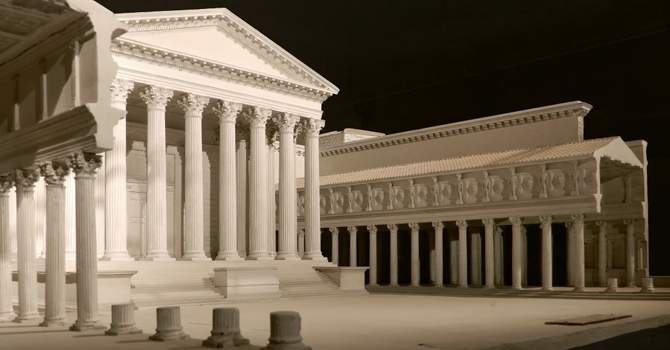The second phase of Civis Civitas Civilitas, the exhibition that aims to show how Roman culture took root in the militarily conquered territories through the model of urban life, which is expressed in the buildings that qualify the city as such, has started on June 29. To do this, the exhibition, at Trajan’s Markets, places side by side buildings of similar functions distributed throughout the cities of the empire and devotes itself to the relationship between city, citizenship and civilization in the Roman world, described through models of ancient architecture.
A short guidebook published by De Luca editori d’Arte has been produced for the occasion, and a photographic atlas of the models is planned for publication after their restoration, published by L’Erma di Bretschneider.
The exhibition project documents the purely urban character of classical culture. The sharing of spaces, buildings and laws constitutes the civitas, the core of Roman civilization. The exhibition is thus a journey through the spaces and buildings of the cities of theEmpire, depicted in plaster models in the Museum of Roman Civilization, largely made by Italo Gismondi for the Augustan Exhibition of Romanity in 1937. The models partly depict the actual state of the monuments in the 1930s, partly their reconstructions: to their intrinsic scientific value they therefore also add the value of documenting monuments that have been transformed or have disappeared, especially in the territories that were the scene of war events.
The exhibition, as a whole, develops seven macro-themes, all represented by the models placed in the Great Hall already for the December 20 opening, and then declined into a series of specific themes: public spaces (indicated by forums, curie, capitolia and temples); water in city decoration (fountains, nymphaeums and baths); spectacle (theaters and amphitheaters); triumph, thehonor and passage (triumphal and honorary arches, city gates); commerce (markets); individual, family and state memory (sepulchres and monuments); infrastructure (bridges, aqueducts, cisterns, water distribution castles).
Standing out for their proportions and accuracy of rendering are the models of the Forum of Augustus, which opens the exhibition and which for its communicative effectiveness has been moved from the room on the women’s gallery upstream to the central chamber of the Great Hall, the Forum of Pompeii with its adjoining buildings, the scene of the theater of Sabratha in Libya, the Baths of Trier in Germany and the Gate known as St. Andrew’s in Autun, France.
The narrative of the itinerary is punctuated by ancient texts relevant to the individual themes and spoken by the narrative voices of the authors themselves or their addressees, represented by casts of statues or portraits from the Museum of Roman Civilization: among these the setting of the baths described by Seneca in a letter to a friend is particularly vivid.
The image of the life of Civitas in the Roman Empire is told, as mentioned, through models of ancient architecture and complemented by sections devoted to infrastructure with 30 new works relating to bridges, aqueducts and markets. A new core of models, consisting of 24 models, 5 reliefs and a portrait. With these new works, the image of Civitas is completed with infrastructure related to mobility (bridges), water (aqueducts and storage and distribution systems), and commerce (markets).
Instead, the infrastructuring of the land constitutes the connective tissue that allows cities to feed themselves with food and water, to exchange goods, and to maintain close contact with the central administration. Roman bridges and aqueducts, often remaining in use or recovered in the post-Antique era, are a true landmark of the penetration of Roman culture and appear in territories even very distant and peripheral to the best-known communication routes. The model of the Pont du Gard, the famous aqueduct that supplied the city of Nemausus(Nîmes) with water, opens this section presided over by a portrait of Nerva. A narrative voice accompanies the visitor with a passage from De Aquaeductu by Frontinus, the architect appointed curator aquarum by Nerva in 95.
Also arriving in the exhibition are models, the restoration of which has been completed, pertinent to the sections already on display since December. These include the spectacular model of the Baalbek sanctuary, while the monumental 1:20 scale model of the Rimini Bridge, still under restoration, will be the last work to arrive on display.
For all information you can visit the official website of Trajan’s Markets.
 |
| Ancient Romans exported their culture through the urban way of life: an exhibition at Rome's Mercati di Traiano tells the story |
Warning: the translation into English of the original Italian article was created using automatic tools. We undertake to review all articles, but we do not guarantee the total absence of inaccuracies in the translation due to the program. You can find the original by clicking on the ITA button. If you find any mistake,please contact us.